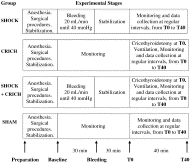The influence of hemorrhagic shock on ventilation through needle cricothyroidotomy in pigs
Affiliations
- Surgery Department, Paulista School of Medicine, Federal University of São Paulo
- Department of Medicine, State University of Maringá, PR, Brazil
Correspondence
- Corresponding author. Rua Fernandez Vieira, 1068, 87010-340 Maringá, PR, Brazil. Tel.: +55 44 3222 5602; fax: +55 44 3011 9423.

Affiliations
- Surgery Department, Paulista School of Medicine, Federal University of São Paulo
- Department of Medicine, State University of Maringá, PR, Brazil
Correspondence
- Corresponding author. Rua Fernandez Vieira, 1068, 87010-340 Maringá, PR, Brazil. Tel.: +55 44 3222 5602; fax: +55 44 3011 9423.
Affiliations
- Surgery Department, Paulista School of Medicine, Federal University of São Paulo
Affiliations
- Surgery Department, Paulista School of Medicine, Federal University of São Paulo
Affiliations
- Surgery Department, Paulista School of Medicine, Federal University of São Paulo
Affiliations
- Department of Medicine, State University of Maringá, PR, Brazil
Affiliations
- Department of Medicine, State University of Maringá, PR, Brazil
 Article Info
Article Info
To view the full text, please login as a subscribed user or purchase a subscription. Click here to view the full text on ScienceDirect.

Fig. 1
Study design.
Fig. 2
Arterial pH behavior during the monitoring period.
Fig. 3
PaO2 behavior during the monitoring period.
Fig. 4
PaCO2 behavior over the monitoring period.
Abstract
Background
The aim of this study was to examine the effects of controlled hemorrhage and shock on oxygenation and ventilation using needle cricothyroidotomy and jet ventilation in an animal model.
Methods
Twenty-four male pigs were randomly allocated into 4 groups: SHOCK (animals in hemorrhagic shock only), CRICH (animals that underwent needle cricothyroidotomy only), SHOCK+CRICH (animals in hemorrhagic shock + needle cricothyroidotomy), and SHAM (anesthetized animals submitted to surgical preparation only). All animals were surgically prepared and were observed for a period of 40 minutes (T0 − T40). Hemodynamic and blood gas variables were compared using analysis of variance and Bonferroni post hoc testing at a level of significance of 95%.
Results
CRICH and SHOCK+CRICH developed respiratory acidosis, with a progressive decrease of arterial pH after T20, and they presented a significant increase of PaCO2 levels after T10, when compared with SHAM and SHOCK (P < .001). When SHOCK+CRICH was compared with CRICH, it presented a larger increase of PaCO2 after T10 (P = .036) and an even more significant increase after T20 (P = .009).
Conclusion
Hemorrhagic shock anticipated and intensified the retention of carbon dioxide and respiratory acidosis during manual jet ventilation through needle cricothyroidotomy in comparison with animals with jet ventilation but without shock. The results found in this work should be considered in future protocols for the assistance of victims of trauma in prehospital settings.
To access this article, please choose from the options below
Purchase access to this article
Claim Access
If you are a current subscriber with Society Membership or an Account Number, claim your access now.
Subscribe to this title
Purchase a subscription to gain access to this and all other articles in this journal.
Institutional Access
Visit ScienceDirect to see if you have access via your institution.
Related Articles
Searching for related articles..


